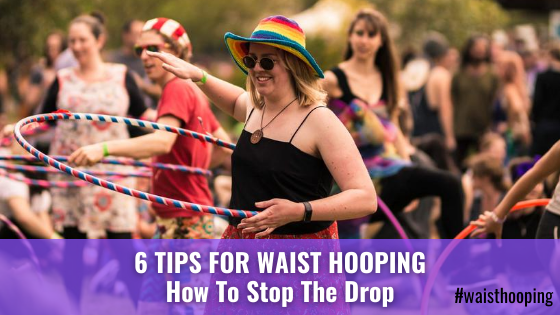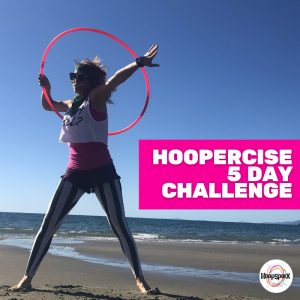Does the hoop keep falling down when you are waist hooping?
If you’ve been struggling to sustain the hoop spinning around your waist, here’s what you need to do.
1. Don’t stop til you get enough!
 Stopping equals dropping. For those of you in Australia you might remember the thing we learned in school about what to do in a house fire: Stop, drop, and roll. Well, that’s pretty much exactly what not to do when you’re waist hooping!! When you stop giving the hoop energy, your hoop drops. It needs a little push each time it goes around. So, every time you feel it touch your belly, give it a push (either side to side or forward and back with your hip movements). Waist hooping is gonna need you to keep on grooving.
Stopping equals dropping. For those of you in Australia you might remember the thing we learned in school about what to do in a house fire: Stop, drop, and roll. Well, that’s pretty much exactly what not to do when you’re waist hooping!! When you stop giving the hoop energy, your hoop drops. It needs a little push each time it goes around. So, every time you feel it touch your belly, give it a push (either side to side or forward and back with your hip movements). Waist hooping is gonna need you to keep on grooving.
2. Focus on a single directional push
 The hoop is a seductress – she is going to try and pull you into following her circular motion. Don’t fall for it!! When you make big circular movements with your hips, you will slow the hoop down and it will eventually fall. Concentrate on moving either side to side or forward and back.
The hoop is a seductress – she is going to try and pull you into following her circular motion. Don’t fall for it!! When you make big circular movements with your hips, you will slow the hoop down and it will eventually fall. Concentrate on moving either side to side or forward and back.
3. Repeat after me: harder, faster!
“So, how do I keep it up?”
“Harder, faster”.
I had this conversation with a fireman who picked up one of my hoops at a festival once. Priceless 😉
Ok, but seriously… We’re working with physics and gravity here, my people! Slower = walking down the body, while faster = moving up the body. As soon as you feel the hoop begin to slow or start to slide downwards, lock into your core and push harder and faster. This does not mean bigger – because bigger ends up being slower as it takes the body more time to complete a bigger movement. When you activate this harder, faster motion, the hoop will pop back up onto your waist! Quite simply, the harder you push, the faster it goes. When I say “push” what I mean is switch on your core and give your hoop some oomph. Your waist hooping will get charged and with the extra force, the hoop will stay in place for more rotations.
4. Turning can save your sweet bippy
 Turning with your hoop slows it down.
Turning with your hoop slows it down.
Turning against your hoop speeds it up.
If you turn in the same direction as your hoop is spinning when you are waist hooping, you will give yourself a moment or two of relief from the pace you need to push to keep it there. It’ll slow the movement down some (but the hoop won’t drop). You might even feel like the hoop sticks to you and floats a little. And then, as you come out of the turn, give the hoop one big push to pick up it’s rhythm again and BAM – it should be back on your waist. A bonus is that when you start to turn closer to the speed of the hoop itself… there are some beautiful stalls and many groovy feels to be had! Thank you Einstein for your theory of relativity.
5. Save it before it enters the abyss (below your butt crack)
 For beginners, waist hooping turns to the dark side when it hits the butt crack. No joke. It’s SO tricky to save it after it descends salaciously past your bodily curvature and below the coccyx (your butt crack bone). Whatever you do, you gotta activate a save (harder, faster or turn and push), take evasive action and stop your waist hooping from going severely south. It’s not impossible to save at this point but it’s wayyyy easier to save it before it hits the hips and beyond.
For beginners, waist hooping turns to the dark side when it hits the butt crack. No joke. It’s SO tricky to save it after it descends salaciously past your bodily curvature and below the coccyx (your butt crack bone). Whatever you do, you gotta activate a save (harder, faster or turn and push), take evasive action and stop your waist hooping from going severely south. It’s not impossible to save at this point but it’s wayyyy easier to save it before it hits the hips and beyond.
6. Stay to the rhythm, and why practice = no more drops
 You know how when you walk down the street you can kind of get into a two-step groove? Especially if you have your tunes on? Hooping is pretty similar in that with each rotation nothing much has changed – you are the same size in space and so is your hoop, so in order to keep it up you have to find the right rhythm for your hoop and your body. Hint: bigger hoops are actually slower than you think – the rhythm lies in the belly and noticing each time it touches your belly.
You know how when you walk down the street you can kind of get into a two-step groove? Especially if you have your tunes on? Hooping is pretty similar in that with each rotation nothing much has changed – you are the same size in space and so is your hoop, so in order to keep it up you have to find the right rhythm for your hoop and your body. Hint: bigger hoops are actually slower than you think – the rhythm lies in the belly and noticing each time it touches your belly.
If you want to dive in deeper, get some guidance or learn a bunch more moves, check out our live online Beginner Course with class videos available. We got you covered for your waist hooping adventure – and beyond!






